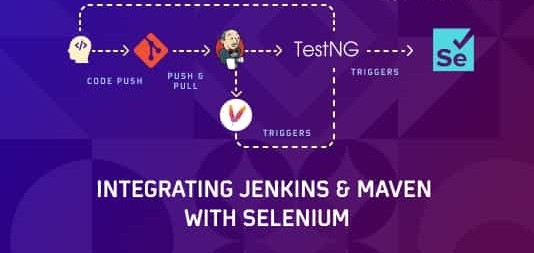How to Integrate Selenium testing with Jenkins for CI/CD Pipelines

Introduction
Picture this: your team pushes new code daily. You want to ensure nothing breaks, but testing manually slows things down. The solution? Integrating Selenium testing with Jenkins—a game-changer for modern CI/CD pipelines. With this integration, every code change triggers automated Selenium tests, giving instant feedback.
If you’re taking a Selenium certification online, or enrolled in an online Selenium course, learning this integration is critical. It’s the backbone of efficient test automation training. Whether you're a developer, QA engineer, or DevOps enthusiast, mastering Jenkins and Selenium together sets you apart in today’s agile world.
What is Jenkins and Why Use It with Selenium?
Jenkins is an open-source automation server used for continuous integration and continuous delivery (CI/CD). It lets you automate tasks like code building, testing, and deployment.
Selenium is a popular tool for automating web application testing. When integrated with Jenkins, you can execute Selenium scripts automatically after each code commit, ensuring early bug detection.
Why is this integration essential?
-
Speed: Automate testing after each update.
-
Accuracy: Run consistent tests across environments.
-
Efficiency: Cut down manual efforts.
-
Agility: Enable DevOps practices in your workflow.
This integration is a key component in most test automation training curriculums and is vital for those pursuing a Selenium certification online.
Benefits of Jenkins-Selenium Integration in CI/CD
Here’s why top tech companies use Jenkins and Selenium together:
-
Continuous Feedback Loop: Get notified when tests fail.
-
Scalability: Easily run tests on multiple machines.
-
Version Control Integration: Link with Git, GitHub, Bitbucket.
-
Custom Pipelines: Use Jenkinsfiles to define your CI/CD flow.
-
Automation Coverage: Expand test coverage with ease.
This is especially useful for candidates involved in online Selenium training, who are preparing for real-world QA roles.
Prerequisites for Integration
Before we dive into the setup, ensure you have:
-
Java installed on your machine
-
Maven or Gradle for project builds
-
Selenium WebDriver
-
TestNG or JUnit as your testing framework
-
Jenkins installed and running locally or on a server
-
GitHub repository with test scripts
-
Basic understanding of Selenium automation testing
If you’re following a Selenium course online, these tools are often part of your toolkit.
Step-by-Step Guide: Jenkins + Selenium Setup
Step 1: Install Jenkins
Download Jenkins from jenkins.io and follow the installation steps for your OS.
Step 2: Configure Jenkins
-
Launch Jenkins at http://localhost:8080
-
Install recommended plugins
-
Create your first admin user
Step 3: Install Required Plugins
Go to Manage Jenkins → Manage Plugins and install:
-
Git Plugin
-
Maven Integration Plugin
-
TestNG Results Plugin (if applicable)
Step 4: Set Up Your Selenium Project
Use Maven or Gradle. Here’s an example pom.xml for a Maven Selenium project:
xml
<dependencies>
<dependency>
<groupId>org.seleniumhq.selenium</groupId>
<artifactId>selenium-java</artifactId>
<version>4.9.0</version>
</dependency>
<dependency>
<groupId>org.testng</groupId>
<artifactId>testng</artifactId>
<version>7.4.0</version>
<scope>test</scope>
</dependency>
</dependencies>
Step 5: Create a Job in Jenkins
-
Click New Item
-
Enter a name and choose Freestyle project
-
Under Source Code Management, enter your GitHub repo URL
-
Under Build, add Invoke top-level Maven targets
-
Goal: test
-
Add a Post-build Action: Publish TestNG/JUnit results
Real-World Example: Automating Test Execution
Imagine a test script that verifies login functionality. Once you commit the code:
-
Jenkins fetches the latest code
-
Maven builds the project
-
Selenium runs automated login tests
-
Results are logged and emailed to the QA team
This setup is essential for any test automation training and is commonly featured in online Selenium courses.
Troubleshooting Tips and Best Practices
Common Issues:
-
Jenkins build fails? Check your pom.xml or Jenkins console log.
-
Git repo not cloning? Validate credentials and access rights.
-
Tests not executing? Ensure test framework (like TestNG) is correctly integrated.
Best Practices:
-
Keep Jenkins plugins updated
-
Store test results and logs systematically
-
Use Jenkins Pipelines for better control
-
Integrate with Slack or email for alerts
-
Modularize Selenium code for reusability
Industry Use Cases and Job Relevance
Companies using Selenium + Jenkins:
-
Netflix
-
Facebook
-
Amazon
-
Walmart Labs
Job Roles Enhanced by This Skill:
-
QA Automation Engineer
-
DevOps Test Engineer
-
CI/CD Specialist
-
Software Development Engineer in Test (SDET)
Learning this through an online Selenium training or Selenium certification course prepares you for roles in modern agile teams.
Final Thoughts
Integrating Selenium with Jenkins isn’t just a technical upgrade it’s a career catalyst. From booting test speed to improving software quality, it adds value to every project and professional. If you're aiming to excel in the field of automation, mastering this integration is a must.
Key Takeaways
-
Jenkins automates test runs and improves CI/CD
-
Selenium ensures thorough web UI testing
-
Integration is key to real-time feedback
-
Ideal for DevOps, Agile, and automation roles
-
Critical skill in most online Selenium courses
Take your test automation skills to the next level. Enroll in our Selenium course online today and master CI/CD with Jenkins!
- Questions and Answers
- Opinion
- Motivational and Inspiring Story
- Technology
- True & Inspiring Quotes
- Live and Let live
- Focus
- Art
- Causes
- Crafts
- Dance
- Drinks
- Film/Movie
- Fitness
- Food
- الألعاب
- Gardening
- Health
- الرئيسية
- Literature
- Music
- Networking
- أخرى
- Party
- Religion
- Shopping
- Sports
- Theater
- Wellness
- News
- Culture

